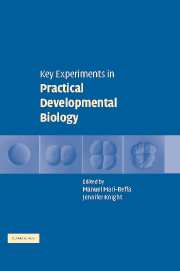Book contents
- Frontmatter
- Contents
- List of contributors
- Preface
- Introduction
- SECTION I GRAFTINGS
- SECTION II SPECIFIC CHEMICAL REAGENTS
- SECTION III BEAD IMPLANTATION
- SECTION IV NUCLEIC ACID INJECTIONS
- SECTION V GENETIC ANALYSIS
- 11 Segmental specification in Drosophila melanogaster
- 12 Genetic analysis of flower development in Arabidopsis thaliana. The ABC model of floral organ identity determination
- 13 Genetic analysis of vulva development in C. elegans
- SECTION VI CLONAL ANALYSIS
- SECTION VII IN SITU HYBRIDIZATION
- SECTION VIII TRANSGENIC ORGANISMS
- SECTION IX VERTEBRATE CLONING
- SECTION X CELL CULTURE
- SECTION XI EVO–DEVO STUDIES
- SECTION XII COMPUTATIONAL MODELLING
- Appendix 1 Abbreviations
- Appendix 2 Suppliers
- Index
- Plate Section
- References
11 - Segmental specification in Drosophila melanogaster
Published online by Cambridge University Press: 11 August 2009
- Frontmatter
- Contents
- List of contributors
- Preface
- Introduction
- SECTION I GRAFTINGS
- SECTION II SPECIFIC CHEMICAL REAGENTS
- SECTION III BEAD IMPLANTATION
- SECTION IV NUCLEIC ACID INJECTIONS
- SECTION V GENETIC ANALYSIS
- 11 Segmental specification in Drosophila melanogaster
- 12 Genetic analysis of flower development in Arabidopsis thaliana. The ABC model of floral organ identity determination
- 13 Genetic analysis of vulva development in C. elegans
- SECTION VI CLONAL ANALYSIS
- SECTION VII IN SITU HYBRIDIZATION
- SECTION VIII TRANSGENIC ORGANISMS
- SECTION IX VERTEBRATE CLONING
- SECTION X CELL CULTURE
- SECTION XI EVO–DEVO STUDIES
- SECTION XII COMPUTATIONAL MODELLING
- Appendix 1 Abbreviations
- Appendix 2 Suppliers
- Index
- Plate Section
- References
Summary
OBJECTIVE OF THE EXPERIMENTDrosophila melanogaster, the fruitfly, is a model organism for the study of multiple biological problems. Likewise, it has served as a teaching instrument to illustrate basic concepts of genetics. In fact, many fundamental genetic principles were discovered in Drosophila.
As is true for all insects, Drosophila is a segmented organism, with well-differentiated cephalic, thoracic and abdominal regions. The segmental specification of these different domains depends on the activity of a group of genes called homeotic or Hox genes, which are distinctively deployed along the antero–posterior axis. These genes also determine the antero–posterior axis in most animal species, including humans. In Drosophila, mutations in the Hox genes cause one segment (or part of it) to substitute for another one. Many of these transformations are easily observed in the embryonic or adult cuticle.
The objective of the experiments detailed below is to study the segmental transformations caused by homeotic mutations in Drosophila and to carry out a complementation analysis between several homeotic mutations. To this aim, two types of experiments are described: (1) A phenotypical study of different homeotic mutations in the adult cuticle and a complementation analysis. (2) A study of the phenotype of homeotic mutations in the embryonic cuticle.
DEGREE OF DIFFICULTY Experiment 1 requires some experience in the handling of the flies, distinguishing males from females, recognising the dominant mutations of the balancer chromosomes and identifying the homeotic transformations, but this is easily acquired.
- Type
- Chapter
- Information
- Key Experiments in Practical Developmental Biology , pp. 127 - 142Publisher: Cambridge University PressPrint publication year: 2005



